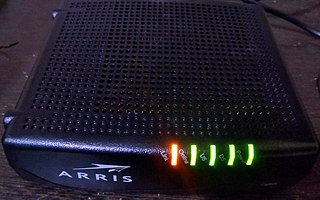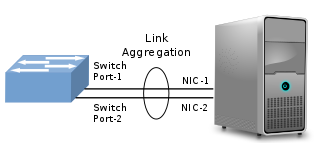Related Research Articles

A cable modem is a type of network bridge that provides bi-directional data communication via radio frequency channels on a hybrid fibre-coaxial (HFC), radio frequency over glass (RFoG) and coaxial cable infrastructure. Cable modems are primarily used to deliver broadband Internet access in the form of cable Internet, taking advantage of the high bandwidth of a HFC and RFoG network. They are commonly deployed in the Americas, Asia, Australia, and Europe.

Multichannel multipoint distribution service (MMDS), formerly known as broadband radio service (BRS) and also known as wireless cable, is a wireless telecommunications technology, used for general-purpose broadband networking or, more commonly, as an alternative method of cable television programming reception.
Data Over Cable Service Interface Specification (DOCSIS) is an international telecommunications standard that permits the addition of high-bandwidth data transfer to an existing cable television (CATV) system. It is used by many cable television operators to provide cable Internet access over their existing hybrid fiber-coaxial (HFC) infrastructure.

Rouzbeh Yassini, known as the "Father of the Cable Modem", is an Iranian-American inventor, engineer, and author, who has gained international reputation as a "broadband visionary" for his pioneering work in broadband industry and inventing the cable modem, establishing the cable modem industry standards (DOCSIS) through Cable Television Laboratories (CableLabs), the Society of Cable Telecommunications Engineers (SCTE) and the International Telecommunication Union (ITU). He is executive director of the University Of New Hampshire Broadband Center Of Excellence and Founder and board member of the YAS Foundation. Yassini is the author of “Planet Broadband”, a humanized look at broadband technology and its contributions to the society, as well as “Broadband Intelligent Series”, a series of white papers on digital services. He is a worldwide speaker and is often interviewed and quoted in the press for his vision on the future of broadband. His lifetime vision and dream is that all the people in the world have ubiquitous access to the broadband and be connected all the time. He believes that broadband connectivity is a fundamental right for all the human beings, what he has referred to it frequently as "Broadband Equality". Yassini was founder, CEO, and president of LANcity, the early pioneer in cable modems. He has worked with Cable Television Laboratories, Inc. (CableLabs) a research arm of the cable television industry in charge of the DOCSIS and on CableHome projects as the cable industry's point man on standardizing the cable modem's global footprint. He served as a senior executive consultant to the cable industry's CEOs while being president and CEO of YAS Corporation. He also has worked with Comcast and Cablevision on numerous programs relating to innovation of broadband technologies. From 2004 to 2007, Yassini worked with the CTO's office at Comcast to create the first industry standard IP-Set top Box specification known as the RNG specification. He has been involved in managing and advising companies ranging from $100 million to $50 billion and served as member of the board of directors on BAS, TrueChat, and Entropic from 2001 to 2008, and UPC Technical Advisory Committee. He created and chaired the Vendor and Operator Executive Advisory Forum of the U.S. Cable Center. He was a member of the Liberty Global Inc. (LGI) advisory technology board from 2001 to 2017. Yassini was director of Visteon from January 2015 to December 2020. As CEO and Chairman of Irystec, a Montreal-based firm founded in 2015 specializing in perceptual display processing technology, Yassini was able to successfully have the french auto company Faurecia acquire the company in 2020, despite the Covid pandemic. Working for more than 30 years in the broadband industry and achieving major accomplishments, Yassini received many awards from different organizations. He was named multiple times as CED Broadband 50 designate. CED Magazine named him “1998 Man of the Year” for creating and fostering the multibillion-dollar cable modem broadband industry. The National Cable & Telecommunications Association (NCTA) awarded Yassini with a 2004 Vanguard Award, the Cable Industry's highest honor in recognition of his contributions and dedication to the industry. The Cable Television Pioneers also inducted Yassini into the class of 2012 for his tremendous and meaningful contributions to the cable industry. He is a member of the Lane Department Academy as well as West Virginia University Academy of Distinguished Alumni.
Cogeco Inc. is a Canadian telecommunications and media company. Its corporate offices are located at 1 Place Ville-Marie in Montreal, Quebec. The company is structured into three strategic business units (SBU); Cogeco Connexion, Breezeline, and Cogeco Media. The company provides a range of telecommunication products and services including cable television, radio and television broadcasting, telephony, and Internet services in Ontario and Quebec in Canada, and in eleven states along the east coast of the United States.

A cable modem termination system is a piece of equipment, typically located in a cable company's headend or hubsite, which is used to provide high speed data services, such as cable Internet or Voice over Internet Protocol, to cable subscribers. A CMTS provides many of the same functions provided by the DSLAM in a DSL system.
OMA SpecWorks, previously the Open Mobile Alliance (OMA) is a standards organization which develops open, international technical standards for the mobile phone industry. It is a nonprofit Non-governmental organization (NGO), not a formal government-sponsored standards organization as is the International Telecommunication Union (ITU): a forum for industry stakeholders to agree on common specifications for products and services.

HomeRF was a wireless networking specification for home devices. It was developed in 1998 by the Home Radio Frequency Working Group, a consortium of mobile wireless companies that included Proxim Wireless, Intel, Siemens AG, Motorola, Philips and more than 100 other companies.
PacketCable network is a technology specification defined by the industry consortium CableLabs for using Internet Protocol (IP) networks to deliver multimedia services, such as IP telephony, conferencing, and interactive gaming on a cable television infrastructure.
The next-generation network (NGN) is a body of key architectural changes in telecommunication core and access networks. The general idea behind the NGN is that one network transports all information and services by encapsulating these into IP packets, similar to those used on the Internet. NGNs are commonly built around the Internet Protocol, and therefore the term all IP is also sometimes used to describe the transformation of formerly telephone-centric networks toward NGN.

In computer networking, link aggregation is the combining of multiple network connections in parallel by any of several methods. Link aggregation increases total throughput beyond what a single connection could sustain, and provides redundancy where all but one of the physical links may fail without losing connectivity. A link aggregation group (LAG) is the combined collection of physical ports.
In telecommunications, cable Internet access, shortened to cable Internet, is a form of broadband Internet access which uses the same infrastructure as cable television. Like digital subscriber line and fiber to the premises services, cable Internet access provides network edge connectivity from the Internet service provider to an end user. It is integrated into the cable television infrastructure analogously to DSL which uses the existing telephone network. Cable TV networks and telecommunications networks are the two predominant forms of residential Internet access. Recently, both have seen increased competition from fiber deployments, wireless, and mobile networks.
Technical Report 069 (TR-069) is a technical specification of the Broadband Forum that defines an application layer protocol for remote management and provisioning of customer-premises equipment (CPE) connected to an Internet Protocol (IP) network. TR-069 uses the CPE WAN Management Protocol (CWMP) which provides support functions for auto-configuration, software or firmware image management, software module management, status and performance managements, and diagnostics.
Communications servers are open, standards-based computing systems that operate as a carrier-grade common platform for a wide range of communications applications and allow equipment providers to add value at many levels of the system architecture.
Cable Television Laboratories, Inc. (CableLabs) is a nonprofit corporation promoting innovation as a research and development lab founded in 1988 by American cable operators. System operators from around the world are eligible to be members.
HPE Service Activator is a service provisioning and activation software platform from Hewlett Packard Enterprise. Once installed and integrated with a Customer Service Provider's (CSP) environment, HPESA automates the processes inherent in the creation and activation of new telecommunications services. It is not specific to any network or service type and can apply across fixed, mobile, or internet environments. HPESA software is activation-centric, but engages the entire fulfillment stack as defined by the TeleManagement Forum's Business Process Framework (eTOM) framework, including order management, resource inventory and service activation.
G.hn is a specification for home networking with data rates up to 2 Gbit/s and operation over four types of legacy wires: telephone wiring, coaxial cables, power lines and plastic optical fiber. A single G.hn semiconductor device is able to network over any of the supported home wire types. Some benefits of a multi-wire standard are lower equipment development costs and lower deployment costs for service providers.
The Broadband Forum is a non-profit industry consortium dedicated to developing broadband network specifications. Members include telecommunications networking and service provider companies, broadband device and equipment vendors, consultants and independent testing labs (ITLs). Service provider members are primarily wire-line service providers (non-mobile) telephone companies.
Operations support systems (OSS), operational support systems in British usage, or Operation System (OpS) in NTT, are computer systems used by telecommunications service providers to manage their networks. They support management functions such as network inventory, service provisioning, network configuration and fault management.
Subisu Cablenet Ltd. is a Nepalese Internet Service Provider company located in Kathmandu, Nepal, and was established in 2001. Subisu employs over 1500 full-time employees, of which around 900 are technical and around 700 are non-technical. As of 2023, the company has over 235,000 customers. It has coverage in all 77 districts of Nepal. Subisu primarily provides cable & fiber internet and Digital TV services through a hybrid fiber-coaxial (HFCC) network. The Internet and 280+ TV channels that it offers provides support to Nepal's educational, entertainment, professional and other sectors. It is the first and the only cable internet service provider in Nepal.
References
- ↑ "Working group will develop IP billing standard" . Retrieved 11 November 2011.
Nineteen network service providers and telecommunication companies have formed a working group to develop an open Internet billing standard.
- 1 2 "IPDR.org Appoints New President and Elects 2002 Board of Directors" . Retrieved 11 November 2011.
IPDR appoints new President and announces Board of Directors.
[ dead link ]